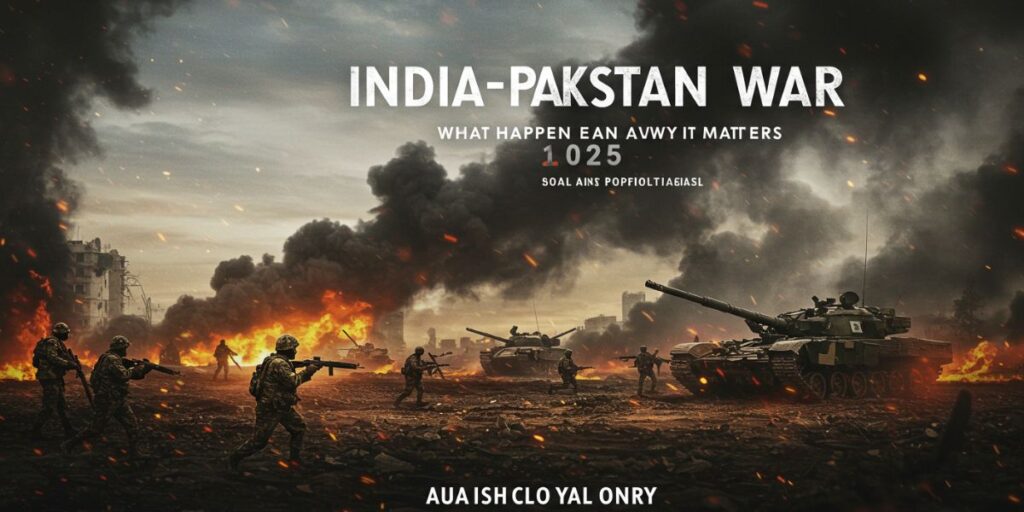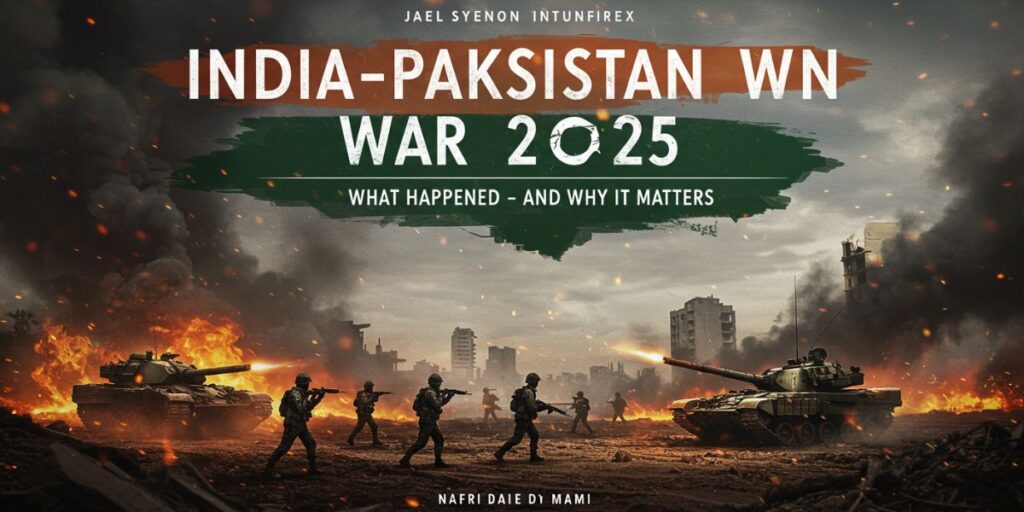
One headline dominated the South Asian news cycle in early 2025: war. Not skirmishes, not warnings, but full-blown conflict. The India-Pakistan War of 2025 didn’t just rattle borders; it shook the psyche of two nations with a long, complicated history. So what went down? And why does it matter now more than ever?

What Sparked the India-Pakistan War in 2025?
Let’s not sugarcoat it — things were tense long before the first shot.
In late January, reports started surfacing about increased ceasefire violations near the LoC (Line of Control). But this wasn’t new. What was new? The intensity. Civilians in Kashmir began evacuating border villages. Suddenly, the phrase “Kashmir war 2025” wasn’t just a hypothetical; it was trending.
Then came the February 3rd drone incident — an Indian Army base in Poonch was hit by what intelligence claimed was a Pakistani-manufactured drone. Pakistan denied involvement. India called it a “blatant act of war.” That’s when the gloves came off.
You know what? People often say, “It’s always Kashmir.” And yes, Kashmir has long been the spark plug. But this time, it wasn’t just about territory — it was about perception, power, and proving a point on the global stage.
Why Did Peace Talks Fail in Early 2025?
There were efforts, sort of.
Backchannel talks reportedly took place in Dubai and Istanbul, facilitated by UAE diplomats and a few Western intermediaries. But those conversations fizzled out faster than a winter bonfire in Gulmarg.
Why? Distrust, mostly. India insisted on public condemnation of terror outfits allegedly operating from Pakistani soil. Pakistan, on the other hand, wanted international mediation — something India has historically refused.
By mid-February, both sides walked away. One diplomat allegedly told Reuters off the record, “It’s like playing chess with a ticking bomb under the table.”
And honestly, that’s what it felt like. Because days later came the real escalation.
How Did the Indian Military Respond?
On February 11, India launched what it described as a “precision retaliatory strike.” This was no isolated airstrike — think wider, bolder, louder.
Targets included suspected terror camps near Muzaffarabad and key Pakistani military installations in the Neelum Valley. The Indian Air Force also used advanced drones and integrated AI-driven surveillance, marking a shift in how warfare is conducted in the region.
This wasn’t your grandfather’s war. It was the Indian military strike of 2025 — surgical, tech-heavy, and relentless.
Ground troops didn’t invade deep — they focused on tactical incursions, pushing back Pakistani forces along critical ridges.
The Indian media called it a “measured response.” But if you were watching NDTV or Times Now? The anchors looked like they were calling a cricket final.
What Was Pakistan’s Strategy in the 2025 War?

If India brought AI and airpower, Pakistan countered with unpredictability.
Pakistan focused on asymmetric warfare. Think cross-border infiltration, cyberattacks on Indian rail networks, and GPS jamming near military zones. There were reports of targeted shelling in Rajouri and Kupwara, displacing thousands.
And then there was the diplomatic blitz. Islamabad ramped up outreach to China, Turkey, and OIC nations, attempting to frame the war as a humanitarian crisis in Kashmir. Whether the narrative stuck or not? That’s debatable. But the effort was massive.
Meanwhile, Pakistani military analysts spoke of “strategic depth”—a” throwback to Cold War doctrine. But in reality, it was a game of attrition. Less about winning, more about not losing.
How Many Lives Were Affected in the Conflict?
This is where things hit hardest — not on the maps, but in people’s homes.
- Over 1,200 soldiers on both sides were reported dead by mid-March.
- Civilian deaths? Around 3,500, most of them in Kashmir.
- More than 90,000 were displaced from Jammu & Kashmir and parts of Punjab.
Hospitals in Srinagar and Rawalpindi overflowed. There were power outages, food shortages, and — worst of all — communication blackouts. Families didn’t know if loved ones were alive.
Even social media couldn’t keep up. Some hashtags were censored; others were flooded with misinformation. And in the middle of all that, ordinary folks just wanted to stay safe.
Could the 2025 War Have Been Avoided?
That’s the million-dollar question, right?
Looking back, analysts say the buildup was obvious, like storm clouds before a downpour. But politics, pride, and pressure made it harder to pull back.
Some blame the India-Pakistan peace talks in 2025. Others point to rising nationalism on both sides, amplified by elections and media.
One former Indian diplomat put it bluntly: “War wasn’t inevitable — but it was convenient.”
Let that sink in for a second. Convenient.
What Role Did Global Powers Play?
Cue the international circus.
- The US issued a travel advisory and called for restraint — classic move.
- China publicly urged peace while quietly ramping up troop movements near Ladakh. Coincidence? Probably not.
- Russia offered mediation, even suggesting a neutral zone in Gilgit-Baltistan. Didn’t go anywhere.
- The UN? Issued statements. Lots of them.
NATO stayed mostly out of it, though some European countries did threaten sanctions if nuclear rhetoric escalated. Thankfully, it didn’t— but it got uncomfortably close.
You know what’s ironic? Some of the loudest peace advocates were nations that sell arms to both India and Pakistan.
Where Do India and Pakistan Stand Now?

As of May 2025, it’s a fragile ceasefire. Think of duct tape holding together a pressure cooker.
Trade ties remain frozen. Student exchanges and visa approvals? Practically dead. Cross-border shelling has paused, but military buildups near the LOC haven’t eased much.
Both nations claim victory — politically, at least.
But on the ground? It’s complicated.
Families mourn. Infrastructure rebuilds. Social trust cracks — especially in Kashmir, where the scars are deepest.
Still, there are faint signals of something else, too — reflection. From musicians posting peace anthems on YouTube to ex-generals penning op-eds urging dialogue.
Small stuff. But stuff that matters.
Will There Be Another War? What Experts Predict
Short answer? No one knows.
Long answer? Probably not — at least not immediately. Both countries took a hit — economically, militarily, and reputationally. Neither can afford another India vs. Pakistan escalation anytime soon.
But don’t exhale just yet. Experts warn that unless something changes — fundamentally — the cycle could repeat.
One South Asia analyst phrased it best: “India and Pakistan are like two neighbors arguing through a wall. As long as the wall stays up, they’ll keep yelling. Tear it down, and maybe—just maybe—they’ll talk.”
Final Thoughts: Why This War Still Matters
Look — war isn’t just about geopolitics or soldiers. It’s about people. It’s about the shopkeeper in Baramulla whose store got shelled. Or the mother in Lahore who sent her son to the front and never got him back.
The India-Pakistan conflict wasn’t the biggest war of the decade, but it was one of the most personal. For millions.
And while the fighting may have stopped (for now), the aftershocks? They’re still very real.
So, will there be peace? Hopefully. But let’s be honest — hope needs help.
And that helps? It won’t come from missiles or military ops.
It’ll come from conversations.
From the ground up.
From us.